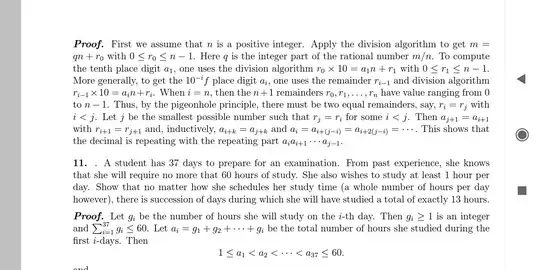By division theorem there are $m = qn + r_0$ where $0\le r_0 < n$.
So $\frac mn = q + \frac {r_0}n$.
Now consider the number the number $K = 10r_0$. As $0 \le r_0 < n$ then $0 \le 10r_0 = K < 10n$.
So be division theorem there are $a_1$ and $r_1$ where $K= a_1n + r_1$ where $0 \le r_1 < n$. But notice that $K < 10n$ so $\frac Kn < 10$ so $a_1 < n$ so $a_1 = 0......9$.
So $K = 10r_0 = a_1n + r_1$.
And $m = qn + r_0 = qn + \frac {10r_0}{10} = qn + \frac {a_1n + r_1}{10}$.
So $\frac mn = q +\frac {a_1 + \frac {r_1}n}{10}=$
$q + \frac {a_1}{10} + \frac {r_1}{10n}$.
And as $q_1 = 0......9$ then $\frac {a_1}{10} = 0.a_1$
and $\frac mn = q.a_1 + \frac {r_1}{10n}$.
======
A concrete example:
Consider $\frac mn = \frac{596}{73}$ (two number off the top of why head).
Now we want $596= q*73 + r_0$ and we get that by
$m = 596 = 8*73 + 12$ where $12 = r_0$ is the remainder.
So $\frac mn = \frac{596}{73} = 8 + \frac {12}{73}$.
Well, there's nothing in the world to stop us from wondering what $10r_0 = 120$ is like. It might not be clear why we wonder but ... we can wonder.
We want $10r_0 = 120 = 73a_1 + r_1$.
What that is solved by
$530 = 73*1 + 47$ where $a_1 = 1$ and $r_1 = 47$.
But what does that mean?
$\frac mn = 8 + \frac{12}{73}=8 + \frac {120}{73*10}$
$=8 + \frac {73*1+47}{73*10}= 8+\frac {73*1}{73*10} +\frac {47}{73*10}$
$=8 + \frac 1{10} + \frac {47}{73*10}=8.1 + \frac {47}{73*10}$.
And that $1 = a_1$ serves as our first decimal.
